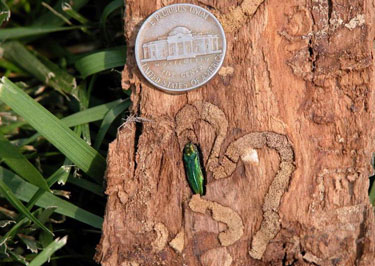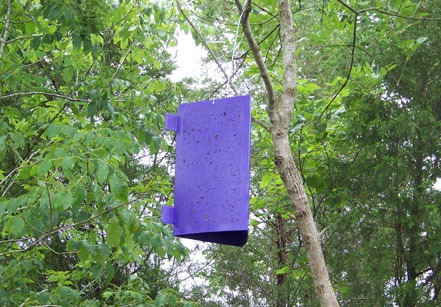
By Nancy Arsenault

Virginia Coop Ext
While the Asian Long Horned Beetle may have spared your most beloved shade trees, now it’s time to keep an eye out for the next deadly pest– the Emerald Ash Borer.
Last week, the state’s first EAB was found on a tree in the Berkshire County town of Dalton, one year after a single EAB beetle had been detected in New York State, just beyond the Massachusetts border.
How Serious is the Threat ?
“Emerald Ash Borer is the most destructive forest insect introduced into North America in recent history,” warns the United States Forest Service in a memorandum to arborists, public tree wardens and tree industry professionals. “Our present ability to detect, contain, eradicate, or manage EAB infestations is limited. The eventual loss of the vast majority of ash trees in North America should be anticipated,” it continues.
Tree experts in Berkshire County are especially concerned with the pests’ presence in their region. Of the state’s 4.5 million ash trees, half of those are growing in Berkshire County, which would be the hardest hit area if ash destruction is inevitable.
Here in the eastern part of the state, according to Stow Tree Warden Bruce Fletcher, while ash trees are less prevalent than in the Berkshires, in a town like Stow, they are still plentiful. “Ash trees were commonly planted as street trees in decades and centuries past, because many of our oldest and largest public shade trees today are ash. But there are also plenty of smaller younger ones on our roadsides that are likely volunteers. They can be seen on almost any old road in Stow. Unfortunately, most of the large ones have died and been taken down over the past several decades,” said Fletcher.
The EAB is targeting a tree variety that has already succumbed to disease and illness over the decades, potentially weakening the stock that exists today. “ The ash trees in our area have been dying back for decades now. In a ground survey done in 1964, it was found that 27.2 percent of sampled ash trees in the six-state area surrounding New York State were either dead or dying. And although there have been periods of time when the dieback was static, it has continued to this day. Although ash dieback is considered a disease, professionals are still unsure of its true causes. Many, if not most, of the dead street trees that the Stow Highway Department has been removing over the past couple of decades are ash trees, and many of them have been huge. In spite of the dieback, ash trees are popular nursery stock and therefore have continuously been planted and have volunteered and are therefore still plentiful in Stow,” concluded Fletcher.
Catostrophic Impact

Already, this Asian immigrant has devoured over 50 million ash trees in the Northeast and Canada, after having only been officially identified outside Detroit, Michigan in 2002. The USFS admits that due to poor detecting tools, the insect is found to usually inhabit an area for years before official detection is verified, according to the agency’s most recent report.
An Emerald Ash Borer can completely kill a healthy tree in three to five years, laying eggs deep in its bark over that entire period until a massive colony of beetles is alive and working diligently to devour and suck the life out of the tree, reproducing consistently over that period. There is no guaranteed successful chemical application known to prevent infestation or stop infestation of an EAB to date, though many options are currently being tested by various government agencies.
Methods to detect beetle presence as quickly as possible are already in place along many roadways and near woodlots across Massachusetts. These detection devices appear as dark purple canvas sacks, hanging within the tree limbs. These sacks attract the EAB before it burrows deep into the tree bark, and it was in one of these similar traps that the Dalton beetle was detected .
Residents are asked to be on the lookout for these pests on both private and public property. Look for:
• Tiny, D-shaped exit holes in the bark of ash trees, die-back in the upper third of the tree canopy, and sprouting of branches just below this dead area.
• The Emerald ash borer is a tiny, emerald-green metallic beetle, so small that seven of them could fit on the head of a penny.
To report suspicious tree damage or insect sightings, or to learn more about this pest ,visit www.massnrc.org/pests. You can also call the toll free EAB hotline at 1-866-322-4512.